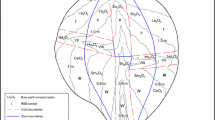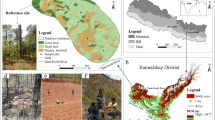Abstract
137Cs is an artificial radionuclide with a half -life of 30.2 years, which was released into the environment as a byproduct of atmospheric testing of nuclear weapons during the period of 1950s to 1970s with a peak deposition in 1963. 137Cs fallout was strongly and rapidly adsorbed by soil particles when it deposited on the ground mostly with precipitation. Its following movements will associate with the adsorbed particles. 137Cs tracing technique has been widely used in soil erosion and sedimentation studies since 1980s. This paper introduces the basis of the technique and shows several case studies of assessment of soil erosion rates, investigation of sediment sources and dating of reservoir deposits by using the technique in the Loess Plateau and the Upper Yangtze River Basin.
Similar content being viewed by others
References
Japan Meteorological Agency (2001) Bulletin of the Radioactivity. Tokyo: JMA. pp 21.
Jing K (1997) Characteristics and change tendencies of environments for soil erosion in the Middle Reaches of the Yellow River. Beijing: Hydrological Publication Horse. Pp 109–137. (In Chinese)
Li H, Zhang XB, Wang KL (2010) Assessment of sediment deposition rates in a karst depression of a small catchment in Huanjiang, Guangxi, southwest China, using the Cesium-137 technique. Journal of soil and water conservation 65(4): 223–232.
Ritchie JC, Mchenry JR (1990) Application of radioactive fallout Cesium-137 for measuring soil erosion and accumulation rates and patterns: a review. Journal of Environmental Quality 19: 215–233.
Rogowski AS, Tamura T (1970) Environmental mobility of Cesium-137. Radiation Botany, 10: 35–45.
Wan GJ, Bai ZG, Liu TQ (2001) The Differential fallout of 137Cs between western Yunnan and central Guizhou: implications for the barrier effect of the Qinghai-Xizang uplift on global atmospheric pollutants in the Yunnan, Guizhou Plateau. Quaternary Science 21(5): 407–415.
Wang XY, Tian JL, Yang MY (2003) The Application of Tracing Method in the Sediment Study, Journal of Sediment Research, 1: 18–23. (In Chinese)
Walling DE, Quine TA (1991) Use of 137Cs measurements to investigate soil erosion on arable fields in the UK: potential applications and limitations. Journal of Soil Science 42: 147–165.
Walling DE, He Q, Quine TA (1995) Use of caesium-137 and lead-210 as tracers in soil erosion investigations. In: Tracer Technologies for Hydrological Systems. IAHS Publ. 229. pp 163–172.
Yan P, Dong GR, Zhang XB (2000) Application of Caesium-137 Technique on Wind Erosion in Gonghe Basin, Qinghai Province, 137Cs Reference Inventory and 137Cs model for Wind Erosion Estimation. Journal of Desert Research 45(6):22–28. (In Chinese)
Yang H, Du M, Chang Q (1998) Quantitative model for estimating soil erosion rates using 137Cs. Pedosphere 8: 21l–220.
Zapata F (2002) Handbook for the Assessment of Soil Erosion and Sedimentation Using Environmental Radionuclides. Vienna: Kluwer Academic Publisher. pp 56–62.
Zhang XB, Higgitt DL, Walling DE (1990) A preliminary assessment of potential for using Caesium — 137 to estimate rates of soil erosion in the Loess Plateau of China. Hydrological Sciences 35 (3): 243–252.
Zhang XB, Quine TA (1993) Influences of tillage on calculation of soil erosion rates by the 137Cs technique. Chinese Science Bulletin 38 (22): 2072–2076.
Zhang XB, Quine TA, Walling DE (1998) Soil erosion rates on sloping cultivated land on the Loess Plateau near Ansai, Shaanxi Province, China: An investigation using 137Cs and rill measurements. Hydrology Processes 12: 171–189.
Zhang XB, Zhang YY, Wen AB (2003) Assessment of soil losses on cultivated land by using the 137Cs technique in the Upper Yangtze River Basin of China. Soil & Tillage Research 69: 99–106.
Zhang XB, He XB, Wen AB (2004) Sediment source identification by using 137Cs and 210Pb radionuclides in a small catchment of the Hilly Sichuan Basin, China. Chinese Science Bulletin 49(18): 1953–1957.
Zhang XB, Walling DE, Yang Q (2006) 137Cs budget during the period of 1960s in a small drainage basin on the Loess Plateau of China. Journal of Environmental Radioactivity 86: 78–91
Author information
Authors and Affiliations
Corresponding author
Rights and permissions
About this article
Cite this article
Long, Y., Zhang, X., Wen, A. et al. 137Cs finger printing technique for erosion and sedimentation studies. J. Mt. Sci. 9, 34–40 (2012). https://doi.org/10.1007/s11629-012-2203-2
Received:
Accepted:
Published:
Issue Date:
DOI: https://doi.org/10.1007/s11629-012-2203-2




